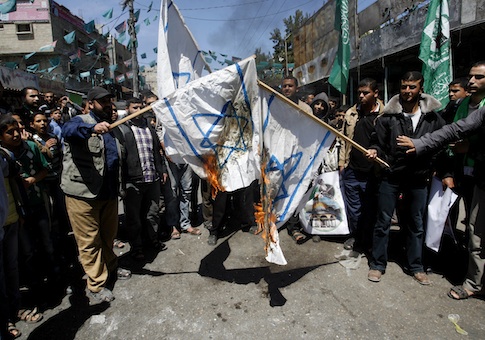The new explanatory journalism venture Vox Dot Com has set its sights on the Israeli-Palestinian conflict. The first page of the entry contained numerous errors. Here you’ll find statements made by Vox followed in brackets by our explanation of what portion of their explanation was inaccurate.
What are Israel and Palestine? Why are they fighting?
Israel is the world's only Jewish state, located just east of the Mediterranean Sea. Palestinians, the Arab population that hails from the land Israel now controls,
[A significant percentage of the ancestors of today’s Palestinians immigrated to the area from bordering regions during and after the early waves of Jewish immigration to Israel, searching for the better economic conditions that prevailed especially during the British Mandate of the 1920s and 1930s.]
refer to the territory as Palestine, and want to establish a state by that name on all or part of the same land.
[Hamas, the terrorist group that controls the Gaza Strip and is popular among West Bank Palestinians as well, is not a Palestinian nationalist group. Hamas' goal is the destruction of Israel and the establishment of an Islamic caliphate, not a Palestinian state.]
The Israeli-Palestinian conflict is over who gets what land and how it's controlled. Though both Jews and Arab Muslims date their claims to the land back a couple thousand years,
[The Muslim conquest of the Levant that brought Arabs to the area took place in the early 7th century AD, 1,400 years ago. Ancient Israel took form around 1,200 BC, 3,200 years ago. Jews thus predated Muslims in the area by approximately 1,800 years.]
the current political conflict began in the early 20th century. Jews fleeing persecution in Europe
[The first significant Jewish aliyah, or immigration to Israel, began not in the early 20th century but in the 1880s and came from Jewish populations in the Russian Empire, not Europe. European aliyah to Israel did not commence in significant numbers until after World War One.]
wanted to establish a national homeland in what was then an Arab- and Muslim-majority territory in the British Empire.
[The territory in question was part of the Ottoman Empire until the end of World War One. The British Mandate for Palestine wasn't codified until the Sykes-Picot Agreement during World War One and didn't commence until after the end of the war.]
The Arabs resisted, seeing the land as rightfully theirs. An early United Nations plan to give each group part of the land failed,
[Curiously absent context: The UN Partition Plan of 1947 failed because the Arabs rejected it. The pre-state Jewish government accepted it.]
and Israel and the surrounding Arab nations fought several wars over the territory. Today's lines largely reflect the outcomes of two of these wars, one waged in 1948 and another in 1967.
[Curiously absent context: Both wars were started by coalitions of Arab states, with the goal of destroying Israel and slaughtering its Jewish inhabitants.]
The 1967 war is particularly important for today's conflict, as it left Israel in control of the West Bank and Gaza Strip, two territories home to large Palestinian populations.
Today, the West Bank is nominally controlled by the Palestinian Authority and is under Israeli occupation.
[In order for a territory to be considered "occupied" it has to have been seized from a state claimant. But the British Mandate ended in 1948, and Jordan relinquished any claim to the territory in 1988. The West Bank is "disputed territory," not "occupied territory"—as both Israel and the Palestinians seek control over it.]
This comes in the form of "settlers," Jews who build ever-expanding communities in the West Bank that effectively deny the land to Palestinians,
[Jewish communities in the West Bank stand on only 1.1 percent of the land.]
and Israeli troops, who protect the settlers and enforce Israeli security restrictions on Palestinian movement.
[Curiously absent context: The West Bank is divided, per the Oslo Accords, into three administrative districts, Areas A, B, and C. Area A, which includes most of the major Palestinian cities, is fully under Palestinian Authority civil and military control and Area B is under joint PA-Israeli control. It is only Area C, where only six to seven percent of West Bank Palestinians live, that is under full Israeli civil and military control.]
Gaza is controlled by Hamas, an Islamist fundamentalist party, and is under Israeli blockade but not ground troop occupation.
[Gaza’s democratically elected Hamas rulers seek Israel’s destruction and are in an open state of war with Israel; even so, the territory is not blockaded, but both Israel and Egypt enforce restrictions on their border crossings with Gaza. Israel also enforces maritime restrictions on Gaza in order to prevent weapons shipments to Hamas and other terrorist groups operating out of the territory.]
The two Palestinian groups may have reconciled on April 23rd, creating one shared Palestinian government for the first time since 2007.
The primary approach to solving the conflict today is a so-called "two-state solution" that would establish Palestine as an independent state in Gaza and most of the West Bank, leaving the rest of the land to Israel. Though the two-state plan is clear in theory, the two sides are still deeply divided over how to make it work in practice.
